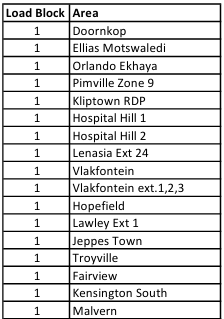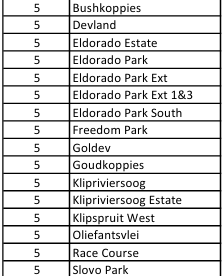- City Power is set to start rolling out scheduled power cuts across Johannesburg during the winter.
- It says that areas across the city will not have power for two and a half hours in peak periods – 04:00 to 10:00 and 18:00 to 22:00.
- Other areas will have geysers in the homes of residents switched off remotely when these areas exceed certain consumption metrics.
Due to energy consumption in the City of Johannesburg reaching “critical levels” according to the municipality’s electricity maintenance company City Power, which has been warning residents for some weeks to use less electricity, a power curtailing initiative will now be rolling out across the city.
City Power calls it “load reduction” and says the measures are being rolled out to “protect the grid from total collapse.” The company says these measures include:
- Remotely switching off geysers in homes at certain times of the day,
- Reducing electrical load at substations around the city that have higher consumption than others at certain times of the day,
- and putting more effort and resources into cutting off illegal connections across the city.
Load reduction will be implemented in 80 areas across Johannesburg, City Power says. These areas will be grouped into 6 blocks and the company says that during peak periods (04:00 to 10:00 and 16:00 and 22:00) rolling blackouts will occur.
These blackouts will not exceed more than two and a half hours per block, so it could be compared to Stage 2 loadshedding.
Here are the City Power blocks and the schedule for load reduction:







The schedule is similar to how Eskom manages loadshedding, in which each block is affected at least once per day. The order of which depends on the day of the month, with no blocks affected between 10:30 and 18:00.
For example, on 10th June, Block 6 will receive power cuts as of 04:00, and at 06:00 Block 4 will start facing outages as Block 6 is turned back on, and so on. The red highlight of Block 1 is used to orient the viewer on the schedule and doesn’t necessarily represent anything else about Block 1.
Importantly, this initiative is not the same thing loadshedding from Eskom, as the national utility has miraculously maintained a suspension on rolling power cuts for nearly 80 days due to improvements in renewable energy generation, maintenance schedules and other initiatives started in 2022 that are now providing results.
These load reduction measures will only occur in Johannesburg in areas serviced by City Power. Other areas in the city will only see load reduction in terms of geysers being remotely switched off in homes during peak consumption hours.
City Power says that geysers use around 50 percent of a household’s electricity and thus to preserve the Johannesburg grid, City Power will make use of newly installed Ripple Relays at certain substations to switch off geysers at home. At least 69 of the company’s substations have Ripple Relays which allow the monitoring of live consumption.
“City Power will remotely switch off the customer geyser once they reach high consumption levels,” it said.
If you live in these below areas, beware that your geyser can be switched off remotely:


Switching geysers on and off can be dangerous business, and the act of geysers turning back on and heating water again uses a lot of electricity. City Power has not said what they will do if geysers are damaged during the remote switching off and back on.
“The decision to initiate load reduction follows extensive efforts to encourage customers to use electricity wisely and efficiently in recent weeks,” City Power explains in a statement posted to X.
“Despite warnings about the constrained electricity network in the city, residents have not reduced their electricity consumption and the energy demand continued to rise.”
The company says that it has recorded an “enormous increase” in average evening use in some areas, most likely due to the cold weather. Some areas went up by 65 percent, and in some areas the load reached 110 percent increases.
“With temperatures expected to drop even more between June and July, the consumption levels could have dire consequences on our network infrastructure if load reduction is not urgently implemented,” the company explains.
Why is this happening?
The company does not explain, however, that it failed to prepare adequately for the winter period demand increase.
Winter hits every year, and in South Africa, June and July are widely known to be the coldest months of the year. City Power failed to implement any other precaution in advance, including the addition of capacity to Johannesburg’s ailing power infrastructure.
Instead, they blame the residents of the city, who pay for their own electricity usage. City Power saying that Johannesburg residents failed to heed warnings is a poor excuse. Now these same residents must face blackouts due to the company’s poor preparation. The utility has long known about its infrastructure maintenance backlog, often blaming Eskom loadshedding for faltering systems.
Now that loadshedding remains suspended, it seems they have decided on another scapegoat.
[Image – Photo by Johannes Plenio on Unsplash]

